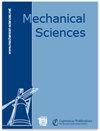多体升沉波浪能量转换系统结构设计及水面浮体能量效率分析
IF 1.5
4区 工程技术
Q4 ENGINEERING, MECHANICAL
引用次数: 0
摘要
摘要由于内部结构和能量供应载体的缺陷,传统的深海无人船用设备无法满足低功耗的要求。本文设计了一个多体垂荡波浪能量转换系统的整体结构,用于捕获和转换波浪能量。转换系统由浮体、水下吸收器和动力输出系统(PTO)组成。通过动态分析,建立了能量转换系统的动态模型和能源效率评价的数学模型。基于南海实际使用环境,对不同形状浮体的能效特性进行了模拟,并对不同形状的浮体的振幅响应算子、辐射阻尼、附加质量和Froude–Krylov力进行了比较。然后,对水面浮体的最佳能效参数进行了探讨。最后,通过能效测试验证了结论的正确性。结果表明,在低功耗和空间规模的限制下,相同海况、相同材料、最大规模的轴对称旋转体能量转换系统可以显著提高转换效率,其中球形旋转体的性能最好,这使得无人值守的船用设备具有广阔的发展前景。本文章由计算机程序翻译,如有差异,请以英文原文为准。
Structural design of multi-body heave wave energy conversion system and analysis of energy efficiency of floating body on water surface
Abstract. Due to the defects of the internal structure and energy supply carrier, conventional deep sea unoccupied marine equipment cannot meet the requirements of low power consumption. In this paper, the whole structure of a multi-body heave wave energy conversion system was designed to capture and convert wave energy. The conversion system consists of a floating body, an underwater absorber and a power takeoff system (PTO). The dynamic
model of the energy conversion system and the mathematical model of energy efficiency evaluation were established according to the dynamic analysis. Based on the real service environment in the South China Sea, the energy efficiency characteristics of floating bodies with different shapes were
simulated, and the amplitude response operator (RAO), radiation damping, added mass and Froude–Krylov force of floating bodies with different shapes were compared. Then, the optimal energy efficiency parameters of surface floating body were explored. Finally, the correctness of the conclusion was verified by the energy efficiency test. The results show that, under the limitation of low power consumption and space scale, the energy conversion system of an axisymmetric rotary body with the same sea conditions, same material and the largest scale can significantly improve the conversion efficiency, and the spherical rotary body performs the best, which makes the
unoccupied marine equipment have a broad prospect for development.
求助全文
通过发布文献求助,成功后即可免费获取论文全文。
去求助
来源期刊

Mechanical Sciences
ENGINEERING, MECHANICAL-
CiteScore
2.20
自引率
7.10%
发文量
74
审稿时长
29 weeks
期刊介绍:
The journal Mechanical Sciences (MS) is an international forum for the dissemination of original contributions in the field of theoretical and applied mechanics. Its main ambition is to provide a platform for young researchers to build up a portfolio of high-quality peer-reviewed journal articles. To this end we employ an open-access publication model with moderate page charges, aiming for fast publication and great citation opportunities. A large board of reputable editors makes this possible. The journal will also publish special issues dealing with the current state of the art and future research directions in mechanical sciences. While in-depth research articles are preferred, review articles and short communications will also be considered. We intend and believe to provide a means of publication which complements established journals in the field.
 求助内容:
求助内容: 应助结果提醒方式:
应助结果提醒方式:


